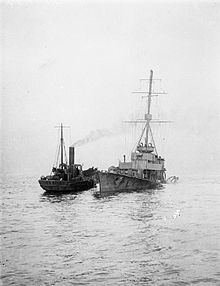Laid down 28 October 1912 Construction started 28 October 1912 Length 133 m | Namesake Arethusa Commissioned August 1914 Launched 25 October 1914 | |
 | ||
Fate Damaged by mine, 11 February 1916 and wrecked Class and type | ||
HMS Arethusa was the name ship of her class of eight light cruisers built for the Royal Navy in the 1910s. She saw a considerable amount of action during the early years of the First World War, participating in the Battle of Heligoland Bight and the Battle of Dogger Bank.
Contents
Design and description
The Arethusa-class cruisers were intended to lead destroyer flotillas and defend the fleet against attacks by enemy destroyers. The ships were 456 feet 6 inches (139.1 m) long overall, with a beam of 49 feet 10 inches (15.2 m) and a deep draught of 15 feet 3 inches (4.6 m). Displacement was 5,185 long tons (5,268 t) at normal and 5,795 long tons (5,888 t) at full load. Arethusa was powered by four Brown-Curtis steam turbines, each driving one propeller shaft, which produced a total of 40,000 indicated horsepower (30,000 kW). The turbines used steam generated by eight Yarrow boilers which gave her a speed of about 28.5 knots (52.8 km/h; 32.8 mph). She carried 840 long tons (853 t) tons of fuel oil that gave a range of 3,200 nautical miles (5,900 km; 3,700 mi) at 16 knots (30 km/h; 18 mph).
The main armament of the Arethusa-class ships consisted of two BL 6-inch (152 mm) Mk XII guns that were mounted on the centreline fore and aft of the superstructure and six QF 4-inch Mk V guns in waist mountings. They were also fitted with a single QF 3-pounder (47 mm (1.9 in)) anti-aircraft gun and four 21 in (533 mm) torpedo tubes in two twin mounts.
Construction and career
She was laid down at Chatham Dockyard in October 1912, launched on 25 October 1913, and commissioned in August 1914 as flotilla leader for the Harwich Force. On 28 August 1914 she fought at the Battle of Heligoland Bight, flying the flag of Commodore Reginald Tyrwhitt. She was seriously damaged by the German cruisers SMS Frauenlob and SMS Stettin and had to be towed home. On 25 December of that year, Arethusa took part in the Cuxhaven Raid and on 24 January 1915 she fought at the Battle of Dogger Bank. Later in the same year she was transferred to the 5th Light Cruiser Squadron of the Harwich Force. In September 1915 she captured four German trawlers. On 11 February 1916 she struck a mine off Felixstowe, drifted onto a shoal while under tow, and broke her back.
